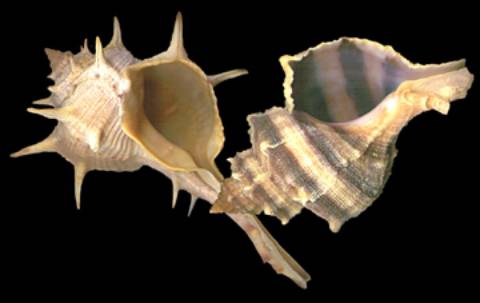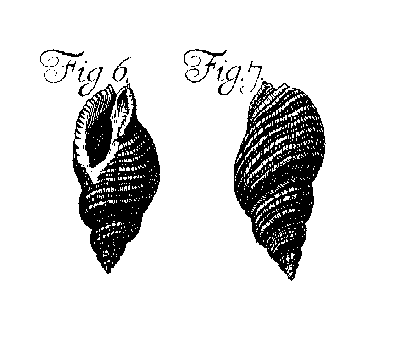
Picture courtesy of the Man and Mollusc Site and Paul Monfils
27th Annual SSRL Users Meeting
Stanford, CA. - October 18th, 2000
Recent Studies of Cartheginian Era Tyrian Purple Artifacts
Tijani KARMOUS, Housam BINOUS and Naceur AYED*
Laboratory of Natural Colorants and Additives
National Institute of Applied Sciences and Technology
BP 676, 1080 Tunis, Tunisia
Naceur.Ayed@insat.rnu.tn
Housam.Binous@insat.rnu.tn
* Author to whom correspondence should be sent ABSTRACT
CONCLUSION
The colorant is the real purple used by the Phoenicians and the Romans. This colorant was found in a clayed support.
The reason for this fact remains unclear. Maya blue is similar to Zembra Punic purple both in usage and preparation. (There are also blue and cyan colored lead crystals found in Mexico.)
Studies concerning Maya blue can provide clues to the understanding of the Punic colorant.

Picture courtesy of the Man and Mollusc Site and Paul Monfils
A sample of purple clay earth dating back to the third century BC is analyzed by several techniques such as HPLC,
X-ray fluorescence, X-ray diffraction, FTIR spectroscopy, scanning electron microscopy....
The precious colorant turn out to be true animal purple, which was, among other things, used in dyeing by the Phoenicians and the Romans.
The support of the colorant was found to be essentially clay containing titanium, phosphorus, calcium, iron, sodium, potassium....
Several interesting questions remain to be elucidated. For instance, it is not clear why the colorant was mixed with clay.
We hope that other techniques such as Synchrotron Radiation analysis
can bring a new insight to this exciting problem. In
particular, we hope to find out more about the possible link between
Maya blue and Punic Zembra purple.
INTRODUCTION
During excavations done at the island of Zembra in Tunisia, we discovered
a sample of purple clay earth in a stratigraphic
layer dating back to the third century BC.
Belonging to an archeological collection and unique in its kind, this
material was studied by several methods of
observation and analysis. The slightly destructive and non-destructive
methods allowed us to have information as
thorough as possible on the coloring matter as well as the support
on which it is fixed. Among the analytical techniques
used, we can mention HPLC, x-ray fluorescence, x-ray diffraction, FTIR
spectroscopy, scanning electron microscopy.
HISTORICAL BACKGROUND OF PURPLE AT CARTHAGE & ARCHEOLOGICAL
DATA OF THE SAMPLE FROM ZEMBRA
Purple dyeing is one of the main industries at the Phoenician and Roman
Carthage. Traces in the form of piles of shells,
testifying the importance of the purple workshops of Carthage, were
pointed out in several sites: Kerkouane, Kram,
Carthage, Utique, Mininx...
Carthage revealed also some signs concerning the purple craft: a shell
of Murex Trunculus was drawn on a Punic seal, a
container filled with broken shell of Murex Trunculus was found and
fragments of shells were found in tombs. All these
facts show the importance of this shell in Carthaginian way of life.
Purple industry has such a scale that Pliny considered
that Mininx purple was among the most beautiful ones.
The archeological matter, that was subject to analysis, was discovered
at the island of Zembra, during excavations
conducted by a team of the National Institute of Patrimony of Tunis,
in a stratum dating back to the third century BC. It is
constituted of purple clay earth, conical shells with an elliptical
base of the Patella genus and granules of wood coal.
CHEMISTRY OF PURPLE
Purple's origins are marine gastropods of the Murex and Purpura kinds,
which contain several precursors of this precious
colorant: indoxyl sulfate esters non-substituted (scheme 1) and indoxyl
sulfate esters substituted in the position 2 by
thiomethyl and sulfonyl methyl groups.
By enzymatic hydrolysis followed by the action of oxygen and light,
these precursors give rise to the purple colorant. The
nature and composition of the pigments of this colorant depend on the
nature of the mollusk species used; this explains
the wide range of shades obtained. In fact, the colorant of Murex Trunculus
is a mixture of indigotin and
6,6'-dibromoindigotin giving purple and blue colorations while Murex
Brandaris and Purpura produce exclusively a
purple red colorant which is 6,6'-dibromoindigotin.
IDENTIFICATION OF THE COLORING MATTER
Several methods were used to identify the colorant of Zembra.
Test of vat and mordant dyeing
Mordant colorants can be extracted in acid medium at 100°C for 10
minutes. While vat colorant develops a
yellow-greenish coloration accompanied by a solubilization of the colorant
under the action of alkali reducing medium
(sodium bisulfate and sodium carbonate).
The acid hydrolysate, analyzed by TLC (run on a silica plate with the
eluent toluene-ethanoic acid 9/1), did not show any
spot. This result indicates that the sample does not contain mordant
colorant. On the other hand, the redox test with
bisulfite is positive. This is an argument in favor of the presence
of indigoic derivatives.
Selective solubility test
We contemplated isolating the pigments constituting the tinctorial form
of the colorant and identifying them by TLC. We
isolated indirubin with ether and indigotin with dichloromethane or
dimethylformamide. Dibromoindigotin is extracted with
quinoleine.
Alteration reaction of dibromoindigotin test
The alkali medium in the presence of a reducing agent degrades the dibromoindigotin
by transforming it into indigotin if the
medium is heated or exposed to UV radiation. This type of reactions
was led on the Zembra sample after elimination of
indigotin and indirubin by solvents. The sample treated this way developed
a blue coloration indicating the formation of
indigotin. This result indicates the presence of dibromoindigotin among
the pigments of the colorant of Zembra. Bromide
is analyzed by TLC using a cellulose plate with the eluent pyridine-distilled
water-isoamylol-ethanoic acid (40/25/20/5).
High performance liquid chromatography analysis
The equipment used in the HPLC analysis consists of a diode array detector
and a C18 inversed phase column. The
analysis of the acid hydrolysate of the Zembra sample gave no peak,
excluding the presence of any mordant colorant.
The chromatogram of the extract with DMSO made at ebullition showed
3 peaks (detected at 288nm) which correspond
to indirubin (1.4%), indigotin (65%) and 6,6'-dibromoindigotin (34%).
This composition shows the animal origin of the
colorant. This colorant is a true purple, which originates from purple
mollusks. The strong percentage of indigotin suggests
that it is mainly Murex Brandaris and Murex Trunculus which were used
by the Phoenicians.
ANALYSIS OF THE SUPPORT
Analysis of the support by x-ray fluorescence
We sorted an ensemble of samples rich in colorant. The spectra of this
ensemble showed profiles that plead in favor of a
clayed matter (Si, Al) more or less rich in iron oxide accompanied
by titanium and salts of potassium, sodium, calcium
essentially.
The fact that we did not detect bromine by x-ray fluorescence in our
samples prompted us to look for a mean to enrich
our sample in colorant. This is possible by a pyridine extraction made
at ebullition after pertinent washing of the sample in
order to eliminate bromide ions due to inorganic mineral salts. Filtration
of the pyridine extract gave a clayed earth residue
in the filtrate, which fixes the colorant. The x-ray fluorescence spectrum
of this residue reveals intense bromide rays. We
compared this spectrum with the one obtained from purple powder from
Monaco.
Analysis of the support by Scanning electron microscopy
The analysis by scanning electron microscopy of the image shown in the
figure and the spectra obtained for the ensemble
of samples rich in colorant indicate the presence of iron, silicon,
aluminium and oxygen. It did not show the presence of
carbon and bromide. The corresponding elemental analysis point out
the following results:
presence of clay (due to aluminium and silicon).
presence of iron oxides probably hematite because of the red color of the earth sample (due to iron and oxygen)
presence of silica grains (due to silicon and oxygen).
it is difficult to link the presence of titanium
to anyone of the minerals mentioned above because no correlation
appears with the other elements. It may be
impurities in iron oxide.
Potassium, sodium and magnesium are detected
only in the presence of chlorine. Thus they are chlorides due to
seawater.
Limestone found in very small amounts suggests
that the sample originates from a dyeing vat, which contained
fragments of shells rich in limestone. This
indicates that our purple was man made. Further excavations are needed
to confirm this supposition.
Analysis of the support by x-ray diffraction
The diffractogram of the Zembra earth rich in colorant shows rays attributable
on one side to kaolin and on the other side
to silica. The same holds for the light gray sample with no colorant.
The ferruginous pigments were not detected by this
technique. This is explained by the fact that they are present in minute
amounts or not properly crystallized.
Analysis of the support by FTIR
The colorant support gives a spectrum similar to washed kaolin. This
result confirms that we are dealing with a kaolinitic
clay.
An ochre sample taken from the Zembra samples gave absorption bands
in IR which were located at the same wave
numbers as those obtained from a reference ochre sample. This analysis
confirms the abundant presence of iron, which
was found in elemental analysis.
Analysis of the support with Raman spectroscopy
This method did not allow the identification of the coloring matter
of the Zembra earth because colorant percentage is
very small. The spectra obtained enabled us to identify mineral components
such as iron oxide and titanium oxide. In
addition, Raman analysis showed the presence of carbon originating
from the coal used as a source of energy in the
preparation of purple by the Phoenicians.
Multi-element analysis of the support
This technique was applied on many samples rich and poor in colorant.
The results plead in favor of a clayed earth
containing SiO2 (50 to 60%) and Al2O3 (16 to 20%). Other elements were
present such as calcium (4.5%), iron (3.2%),
sodium (1.3%), potassium (1.4%), titanium (5000 ppm) and phosphorus
(1350 ppm).
Analysis of the support by x-ray spectrometry induced by proton beam (PIXE)
This analysis concerned three samples chosen according to their colors
: brick red, yellow and purple. The results
obtained for the three samples confirm those obtained by other techniques.
The analysis of the three samples showed that
they are rich in Si (SiO2 : 50 to 60%) and Al (Al2O3 : 23 to 27%).
The results showed that we are dealing with a clayed
earth containing Titanium, calcium, sodium, magnesium as well as other
elements at trace levels such as Sr, Zn, As, Ga...
The different tints of the samples is explained by the abundance of
iron in the brick red sample (Fe2O3 : 19.67%) while
the yellow sample has a smaller content of the iron oxide (Fe2O3 :
2.72%). Bromide is found with highest percentage in
the purple sample (Br : 822 ppm). In the brick red and yellow samples,
the bromide content is around 420 ppm. These
results support the fact that the purple colorant has a strong coloring
power and participate with iron in giving the purple shade to the third
sample.
Tyrian Purple

NEXT, Start RCW Section, teaching pre-school to use the real primarie colors.
PREVIOUS, Bouguereau the Artist